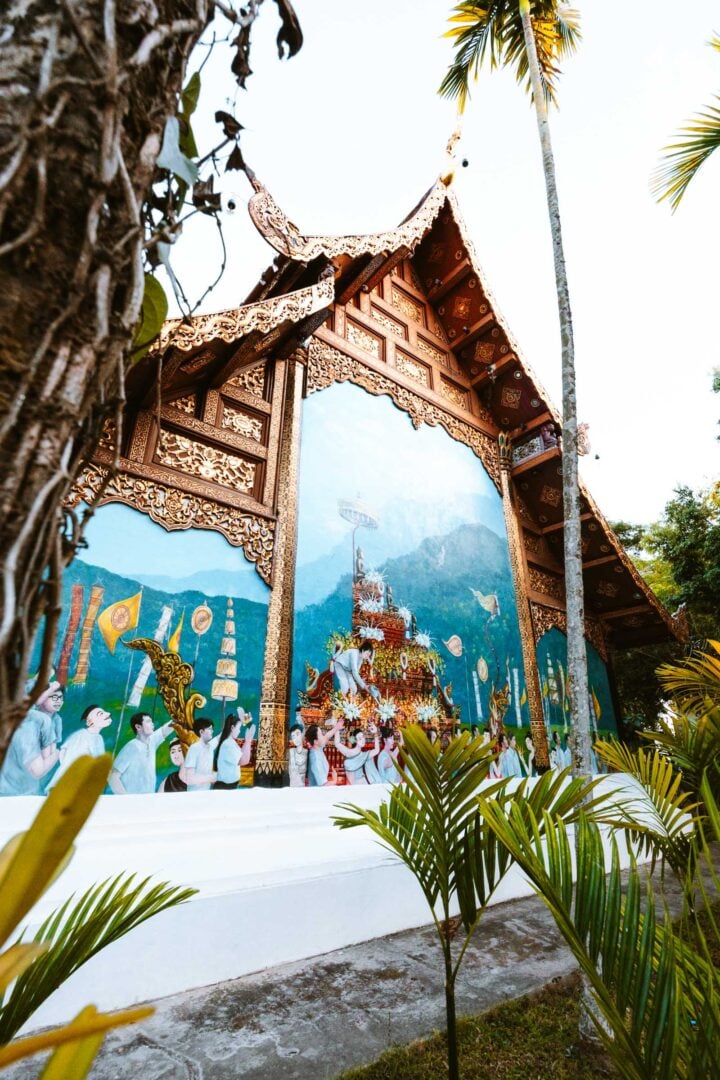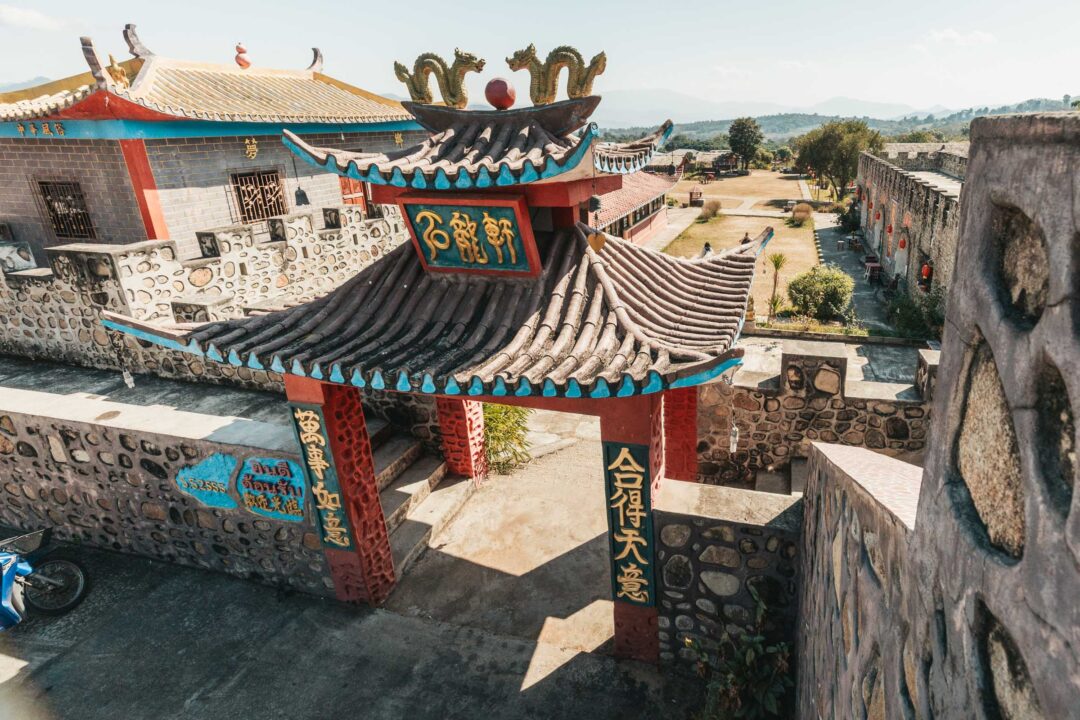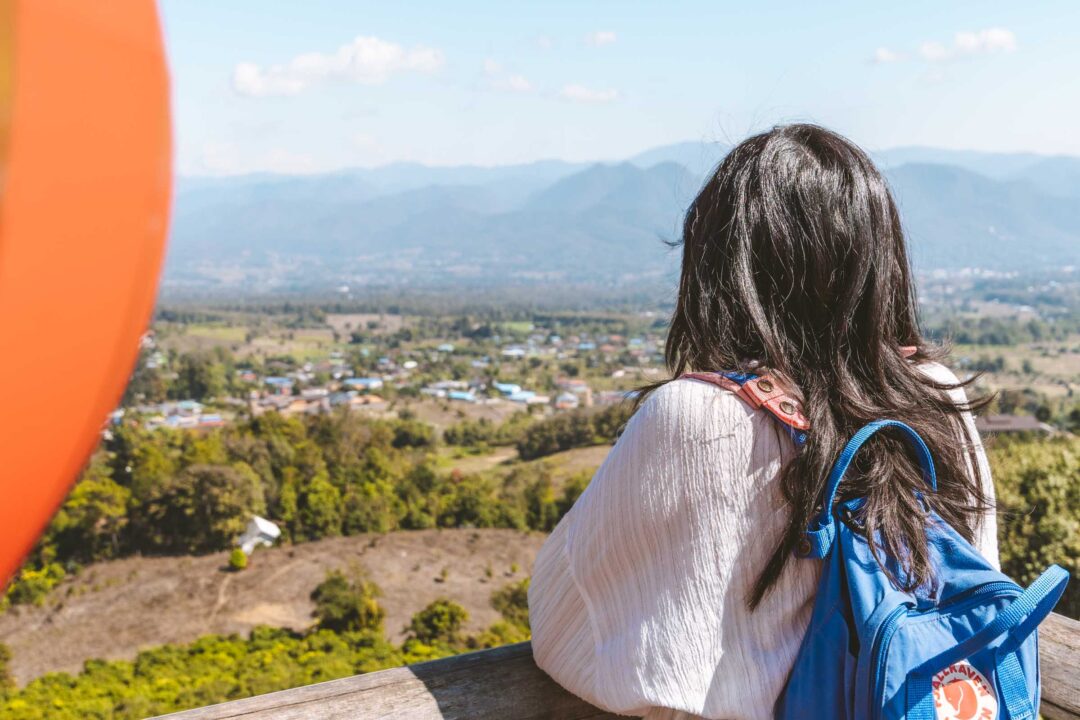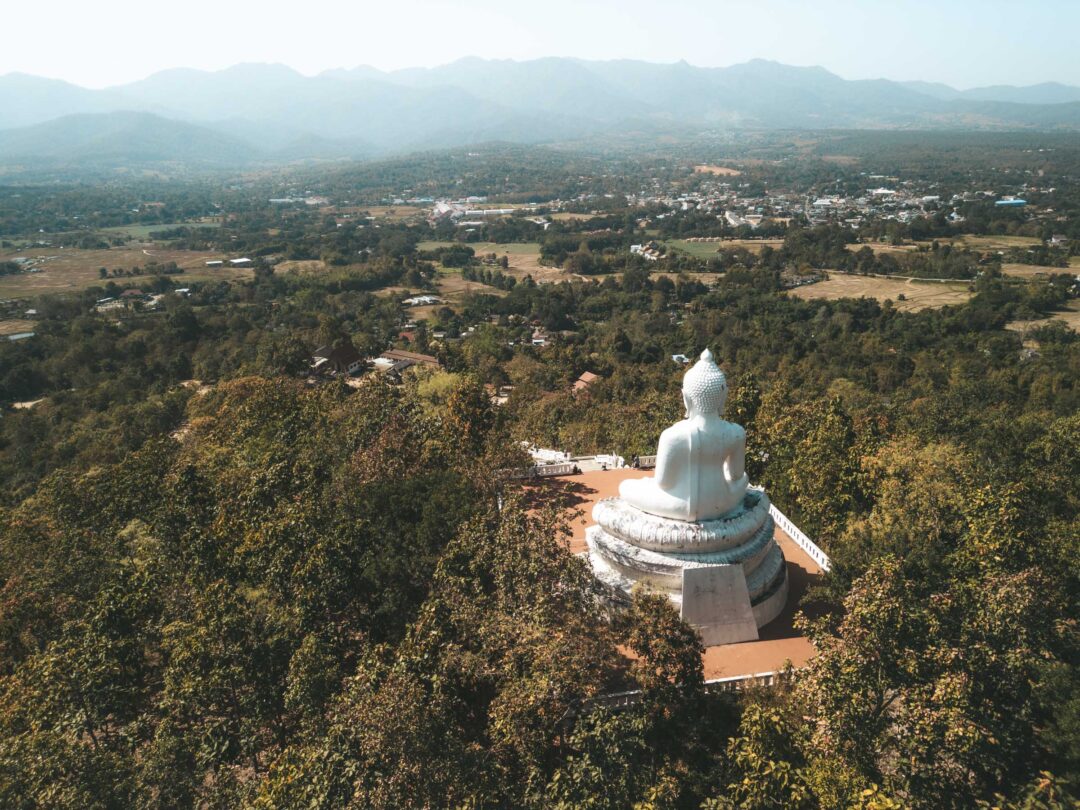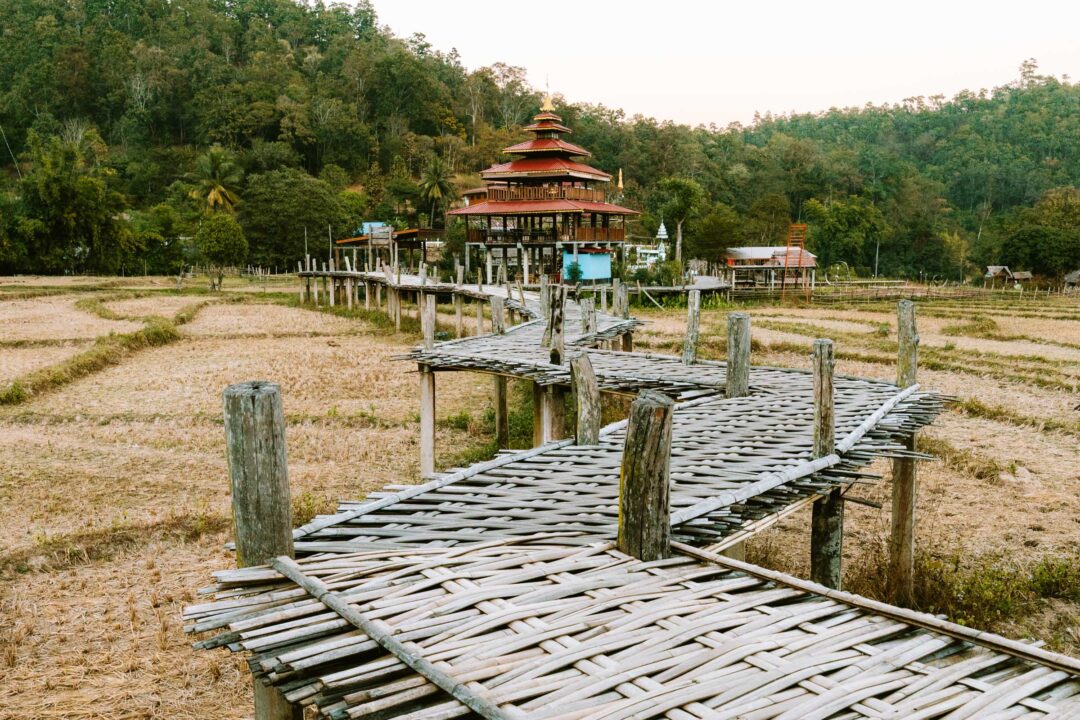Tucked away in the northernmost reaches of Thailand, Chiang Rai stands as a hub of cultural diversity and artistic ingenuity, setting itself apart from other cities in Thailand.
Renowned for its ethereal temples like the White Temple and the Blue Temple, Chiang Rai is a place where art and spirituality converge.
While Chiang Rai is often overshadowed by Chiang Mai, it is just as good, if not a better place for travelers looking for authentic adventures and off-the-beaten path experiences.
If you are based in Chiang Mai you can check out the top-rated Chiang Rai White Black Blue Temple Full Day Tour, which includes transportation and a guide.
9 Awesome Things to Do in Chiang Rai
Most of these activities are right in the city of Chiang Rai. However, some activities are just outside of the city, or a little further from the city center. We stayed near the city center when we did all of these activities, and we had no problems getting around Chiang Rai.
After I go over all of the activities, I’ll share some info on how to get to Chiang Rai and how to get around Chiang Rai, so you plan your transportation to get to and around the city.
Wat Rong Suea Ten (Blue Temple)
- Hours: 7:00 AM – 8:00 PM daily
- Cost: Free
- Location: 📍 Wat Rong Suea Ten (Blue Temple) – Google Maps

The Wat Rong Suea Ten, or the Blue Temple is a piece of contemporary art history. Built in 2016, the temple is both a place of worship and a work in progress where art and spirituality meet.


The connection between the Blue Temple and the famous White Temple isn’t just in their colorful nicknames. The Blue Temple’s architect was a student of the White Temple’s architect, the famous Chalermchai Kositpipat. You can see the similar styles in both temples.

The Blue Temple has an interesting history. There used to be an old temple that existed in the same place, but not many people lived in the area around the temple, so the temple was abandoned around 100 years ago.
When the abandoned temple was rediscovered, tigers roamed freely around its ruins. When the Blue Temple was constructed, it was given the name Wat Rong Suea Ten – meaning “Temple of the Dancing Tiger”
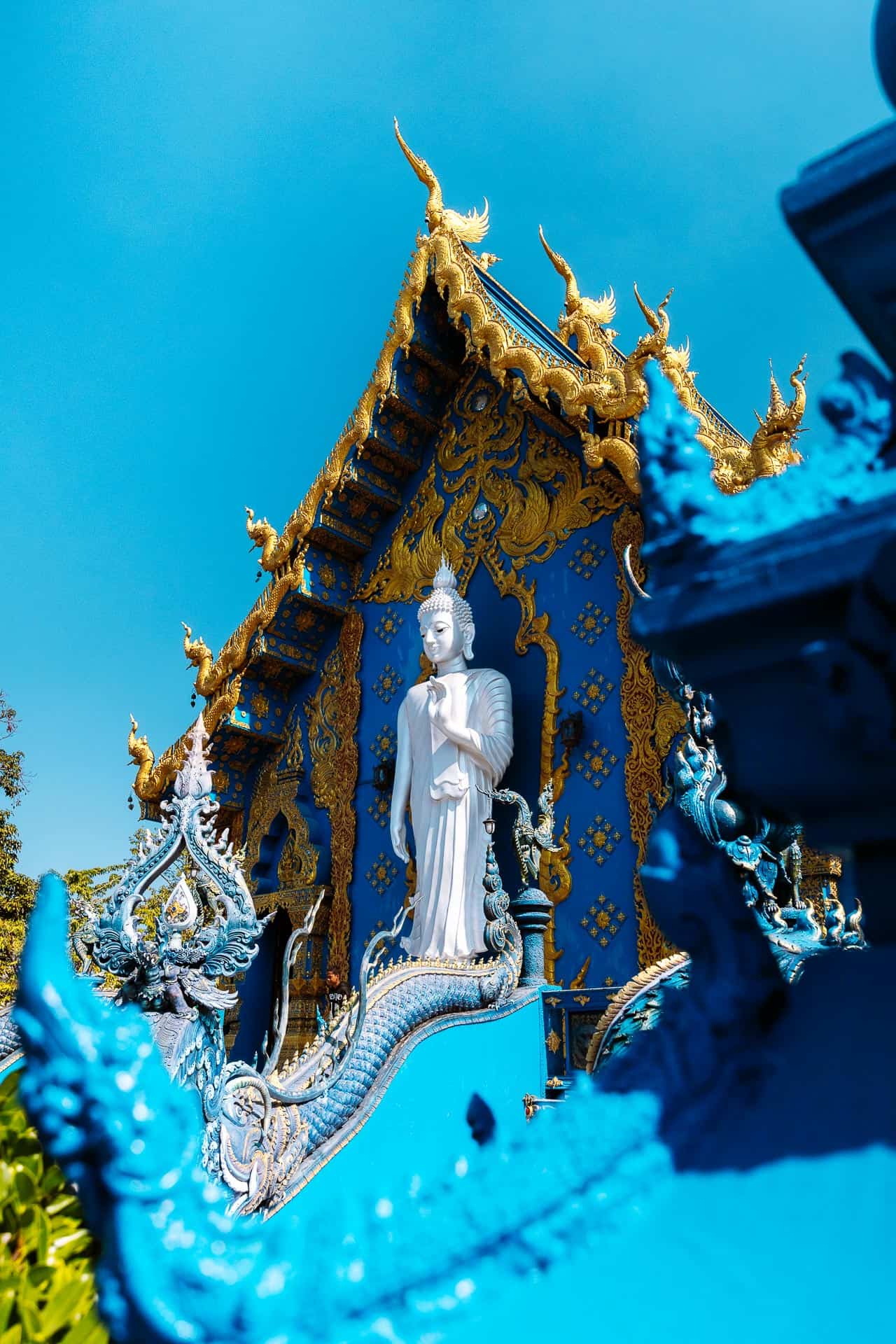
The interior of the Blue Temple is just as stunning as its exterior. The temple houses an impressive 6-meter-tall white Buddha, symbolizing enlightenment with a pose with his hand pointed toward the ground.

When we visited the temple, the walls in the interior of the temple still looked a little blank, with tons of space for future intricate paintings.
Baan Dam Museum (Black House)
- Hours: 9:00 AM – 5:00 PM daily
- Cost: 80 THB per person
- Location: 📍 Baan Dam Museum – Google Maps
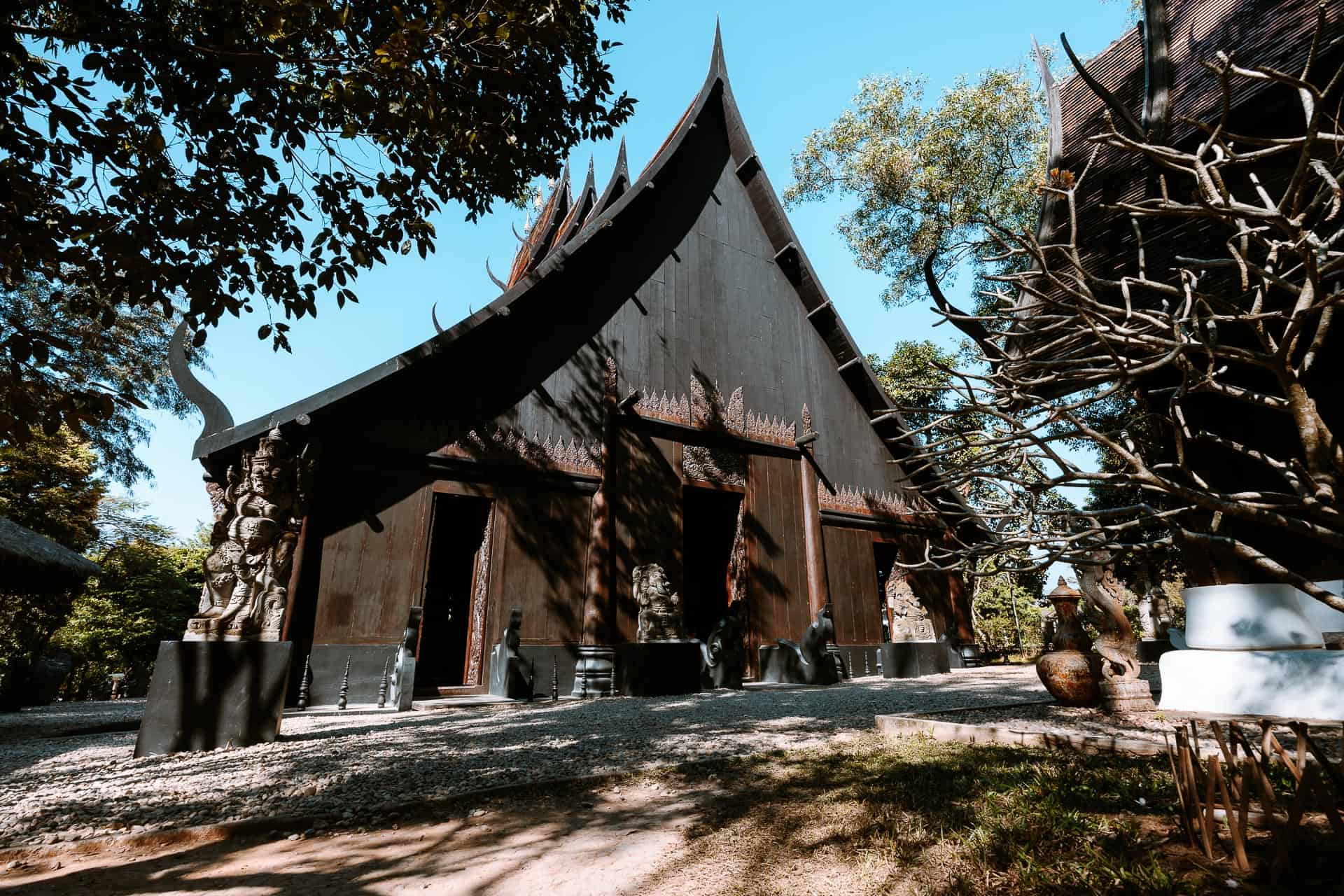
The Baan Dam Museum, or Black House, gives off temple vibes from the outside. But step inside and you’ll find it’s an entirely different world.
Created by the renowned Thai artist Thawan Duchanee, the Black House is his artistic playground, blending deep reflections on Buddhism with his unique creative vision.
Duchanee’s work dives into the complex themes of suffering and greed, elements he saw as central to the human experience through a Buddhist lens. The museum is a stark, thought-provoking journey into these concepts, showcasing the impermanence of life, a fundamental Buddhist principle, through art that explores death, mortality, and the darker sides of existence.
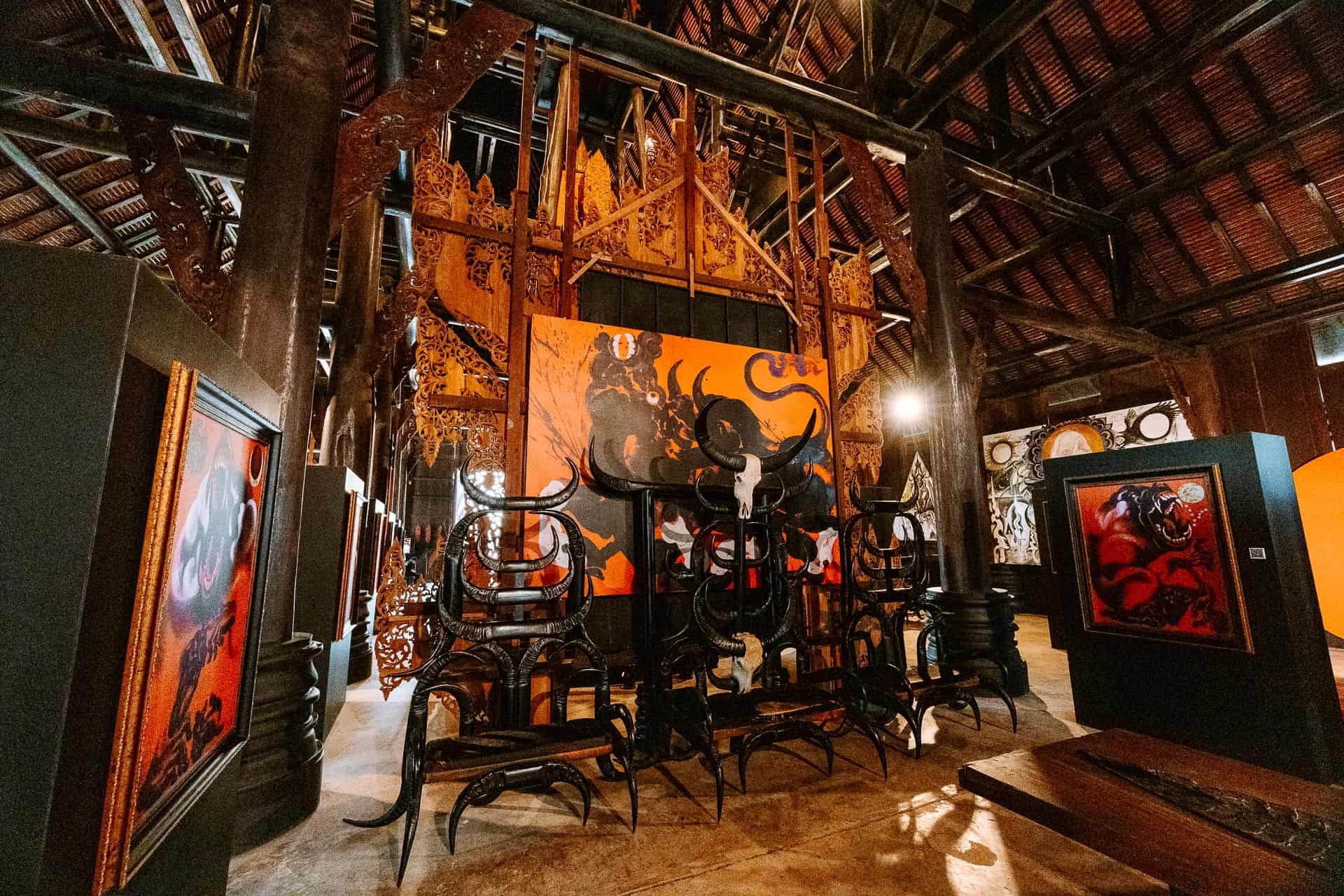
Our favorite part of the museum was the immersive augmented-reality paintings located in the Cathedral, the museum’s central exhibit space. Each piece of art comes with a QR code that, when scanned, directs you to an Instagram filter. This digital magic animated the paintings right on our smartphone screens.

It was thrilling to scan each QR code since we didn’t know how each painting was going to be animated. We loved witnessing static art transform into dynamic scenes on our smartphones, bringing a whole new dimension to the museum experience.
The museum isn’t just one building, it’s a collection of 25 buildings scattered throughout the property. Inside each of the smaller buildings is an art installation, and some of them are completely wild – we didn’t know what to expect every time we peered into a new building.


Thawan Duchanee was a figure of controversy, pushing the boundaries of his Buddhist art to places that some found uncomfortable, leading to acts of vandalism against his works.
Despite the challenges, his artistic skill was recognized by Thailand’s National Culture Commission, honoring him as a National Artist. This award vindicated his bold artistic expressions and firmly established him as a pivotal figure in Thai art.
Khun Korn Waterfall
- Hours: 8:00 AM – 4:30 PM
- Entrance Fee: None
- Hike time: 1 to 1.5 hours (out and back)
- Location: 📍 Khun Korn Waterfall – Google Maps
Khun Korn Waterfall is a hidden gem in Chiang Rai, and getting there is an adventure filled with natural beauty and the serene ambiance of the Thai countryside.

The ride from Chiang Rai, although primarily along a highway, transitions into a scenic route through quaint towns and lush landscapes once you get off the main road.
The trail to the waterfall is an easy, well-maintained path that welcomes hikers of all ages, with signs marking the way. Along the hike, bamboo bridges add a picturesque touch to the route.
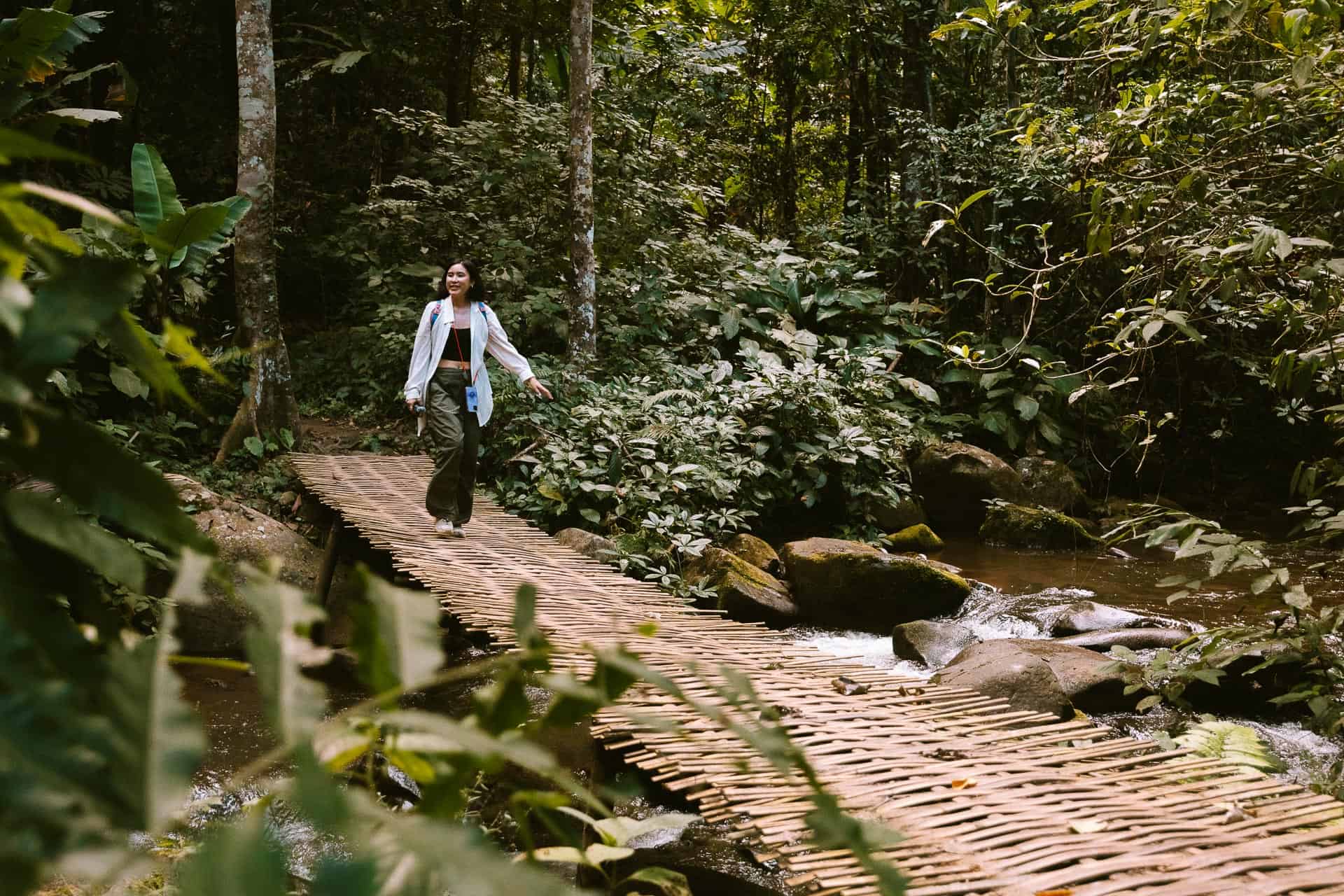
The waterfall itself is a spectacle of nature’s power – its 70-meter drop creates a cool, misty breeze that provides a drenching if you get close.
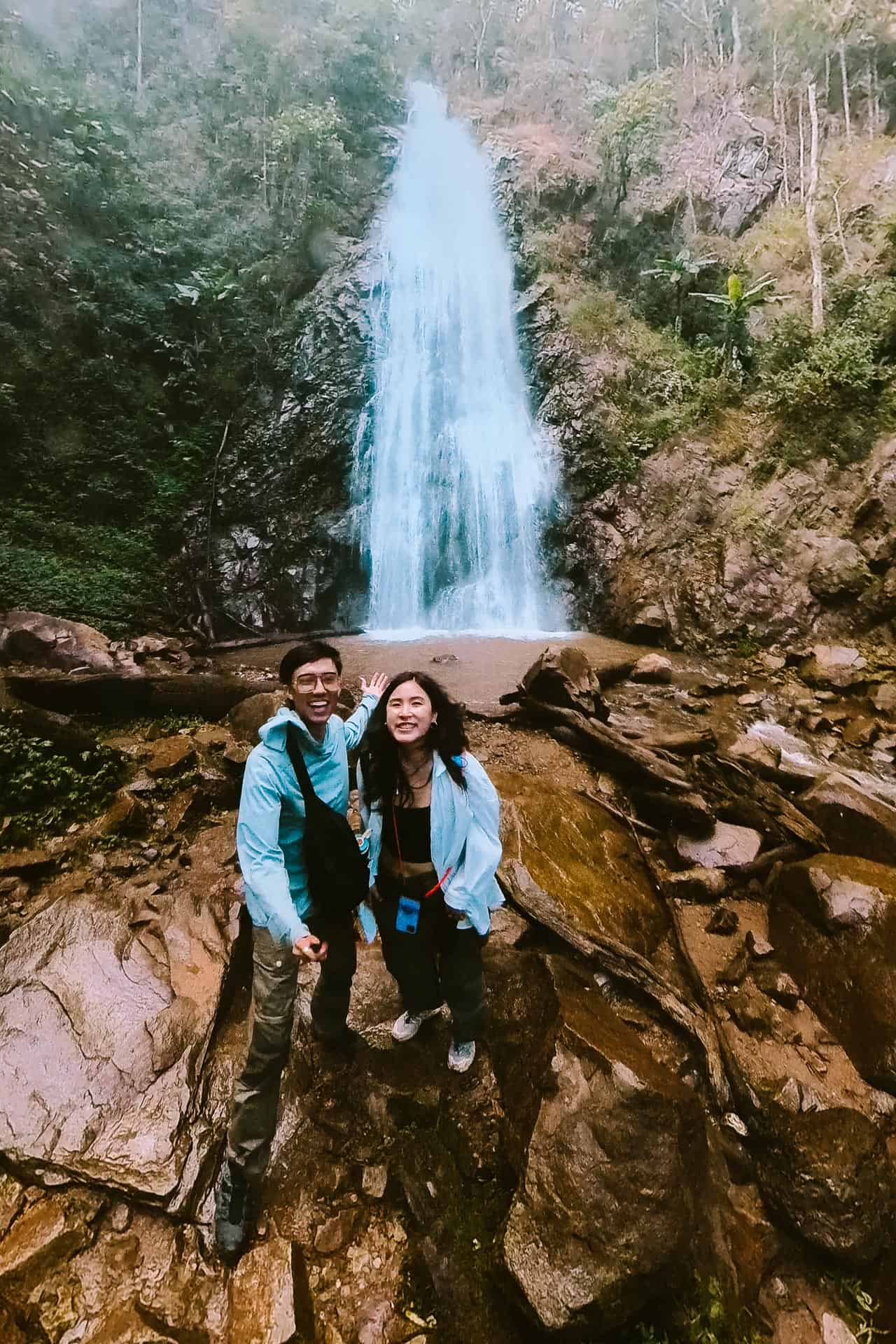
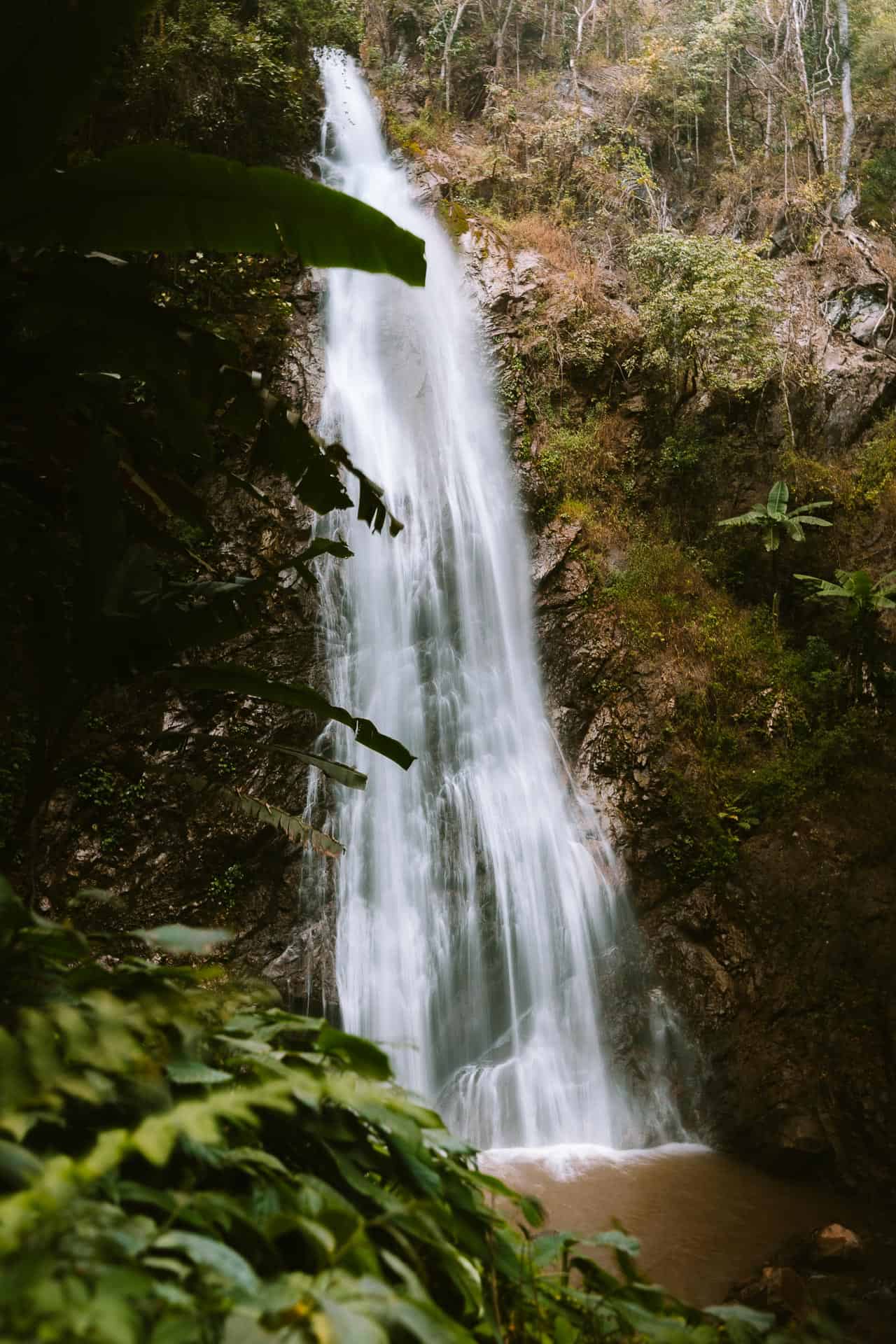

Read our full blog post: Khun Korn Waterfall Hike in Chiang Rai
Wat Rong Khun (White Temple)
- Hours: 8:00 AM – 6:00 PM daily
- Cost: 100 THB per person
- Location: 📍 Wat Rong Khun (White Temple) – Google Maps
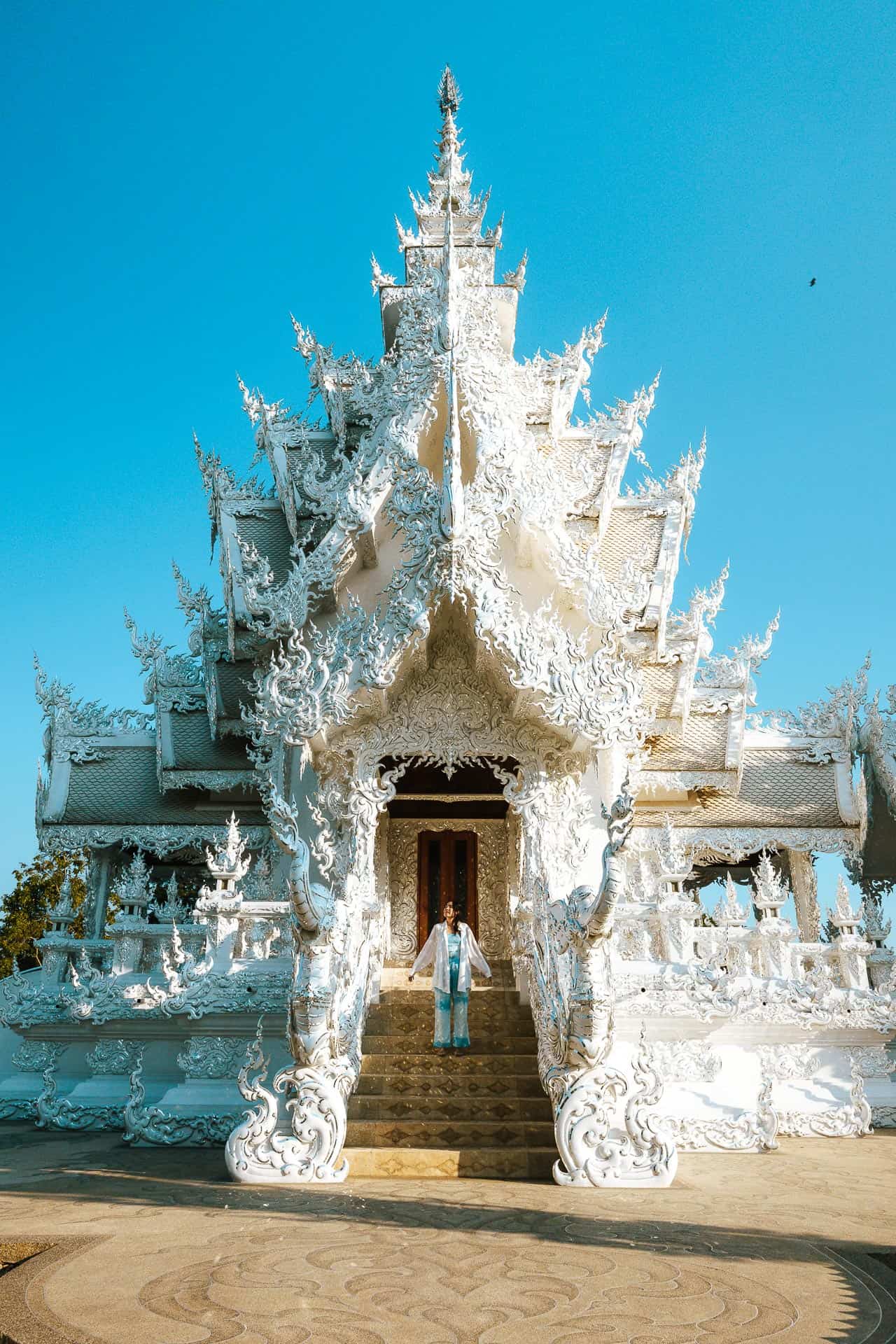
The White Temple is Chiang Rai’s most popular attraction, and it’s easy to see why. This architectural marvel sparkles with its pristine white surface, accented by mirrored inlays that reflect sunlight. Its design is so distinctive, it sets itself apart from any other structure on the planet.
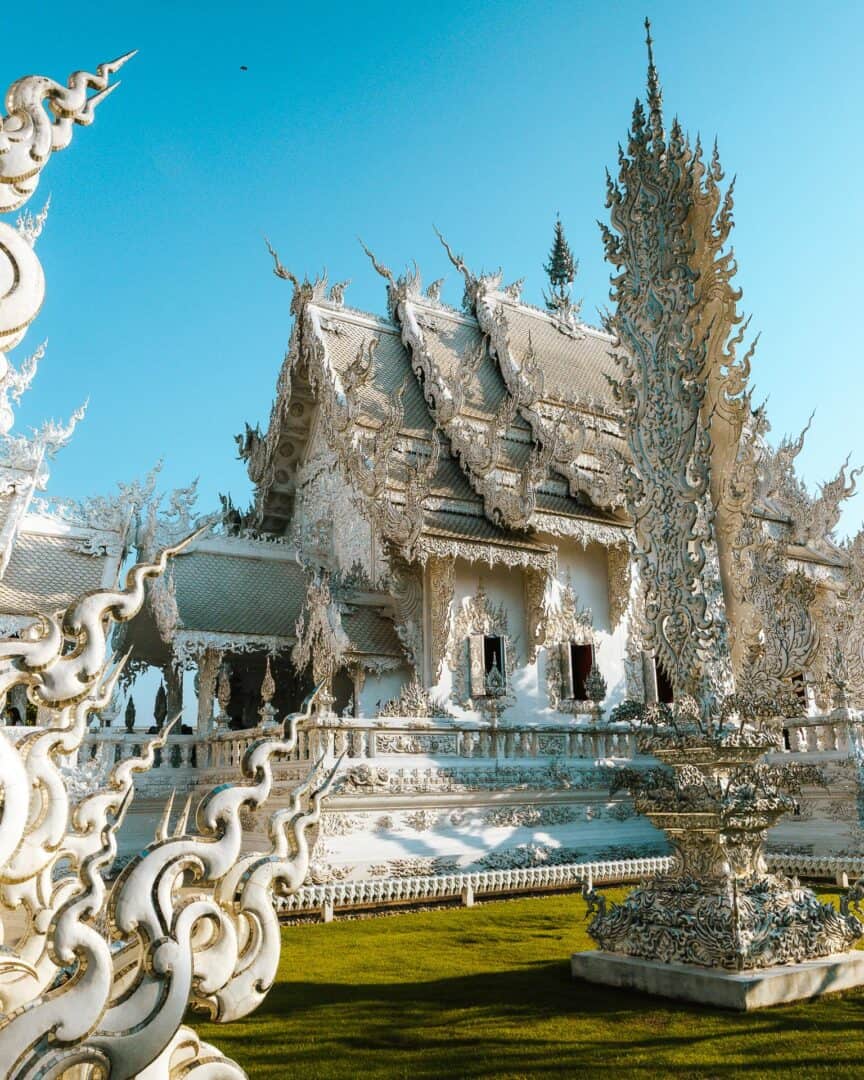
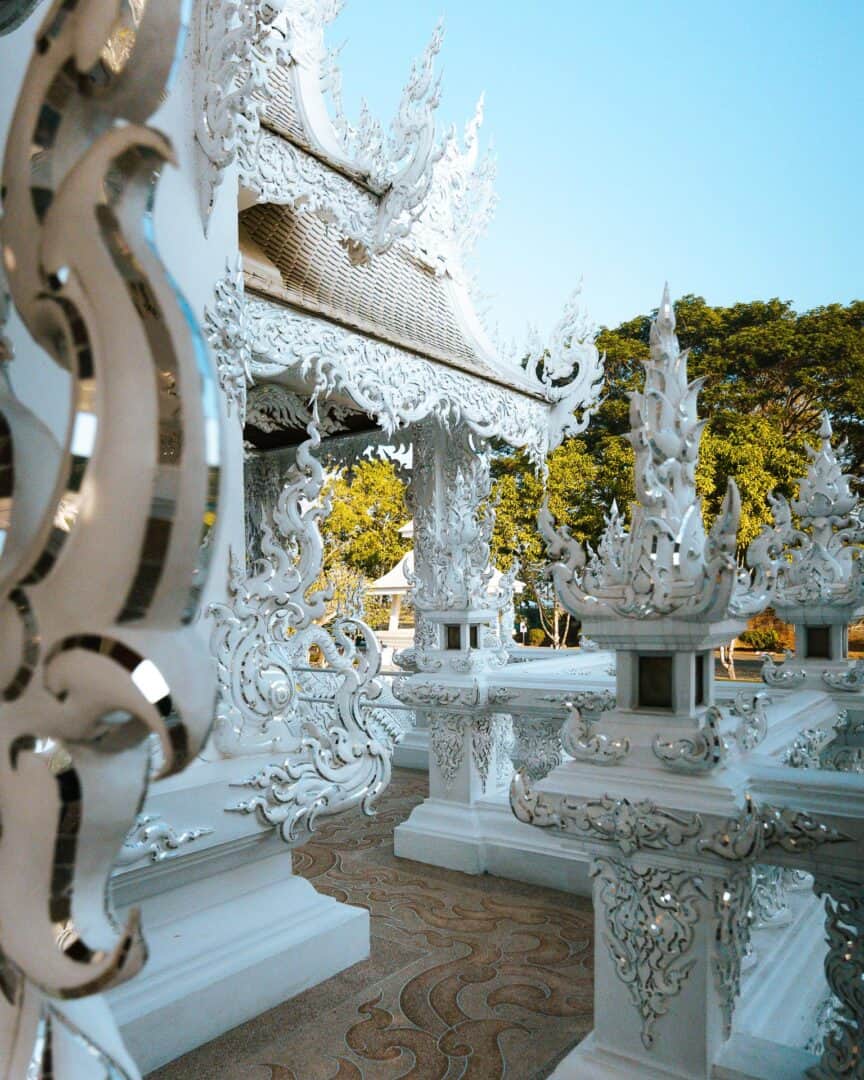
Designed by the visionary Thai artist Chalermchai Kositpipat, the construction of the White Temple began in 1997, and was opened to the public shortly thereafter. However, the White Temple is in constant evolution, with the artist continually adding to the complex.
The entrance to the White Temple is the bridge of “the cycle of rebirth,” leading to the Ubosot, or main temple hall. This bridge crosses over a small lake filled with hands reaching up, symbolizing desire, greed, and the samsara—the cycle of birth, death, and rebirth.
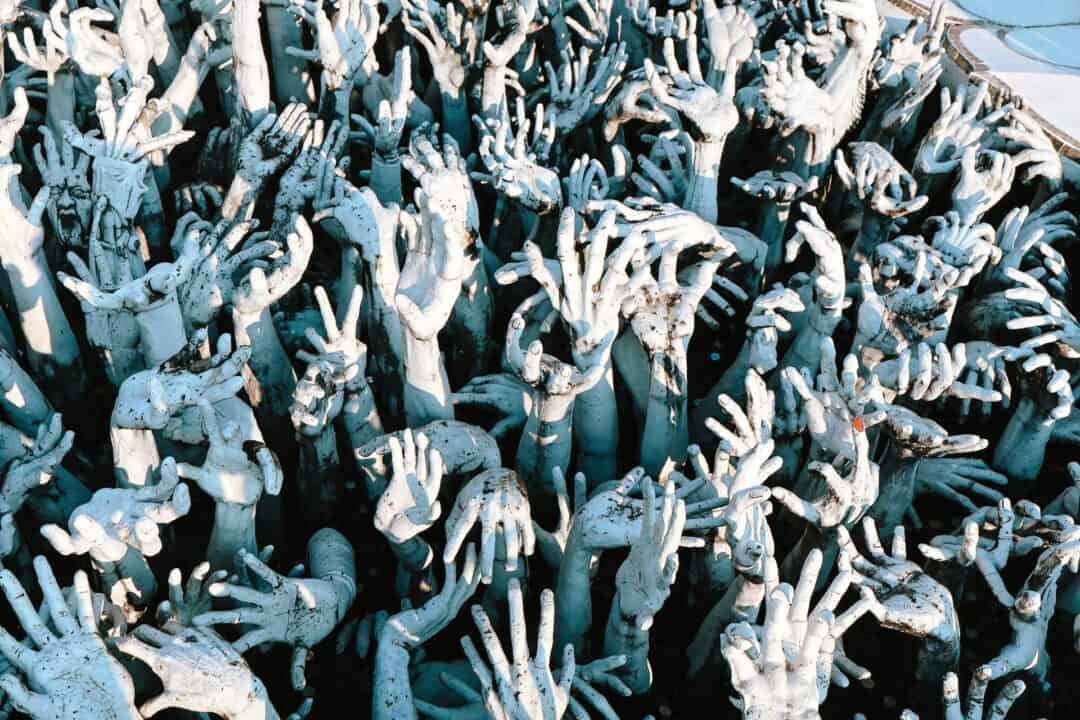
The temple’s white exterior is a symbol of the Buddha’s purity. When you visit, remember it’s a place of religion. You’ll need to remove your shoes before stepping inside and wear clothes that cover your shoulders and knees.
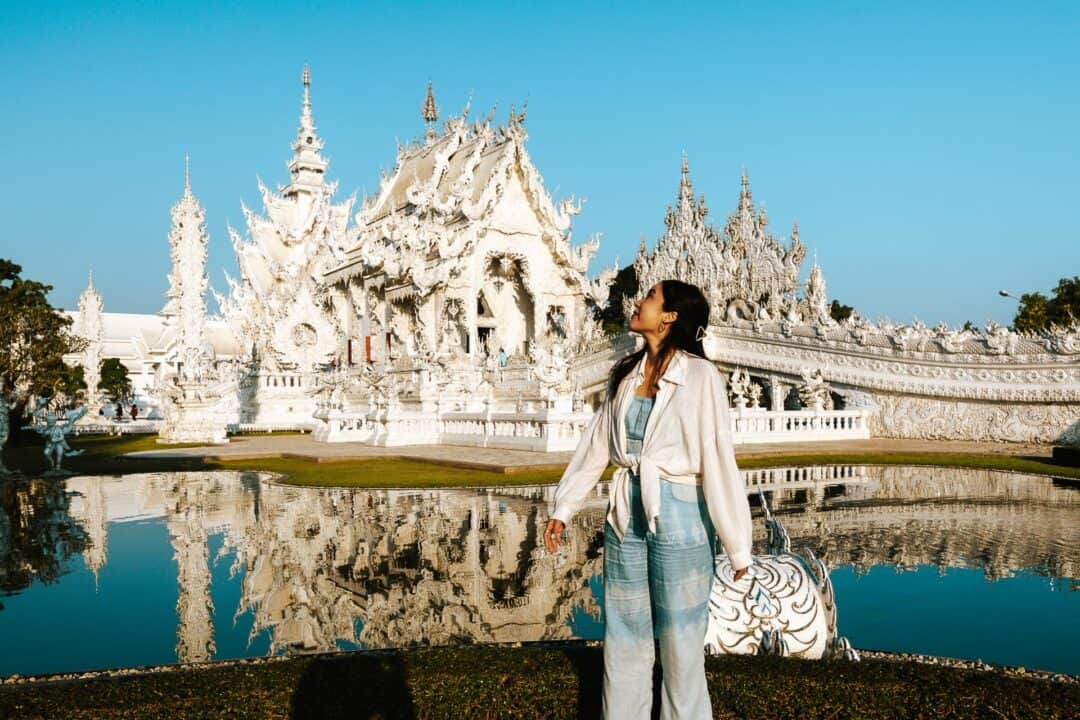
Hilltribe Museum
- Hours: 8:30 AM – 5:00 PM daily
- Cost: 50 THB per person
- Location: 📍 Hilltribe Museum – Google Maps
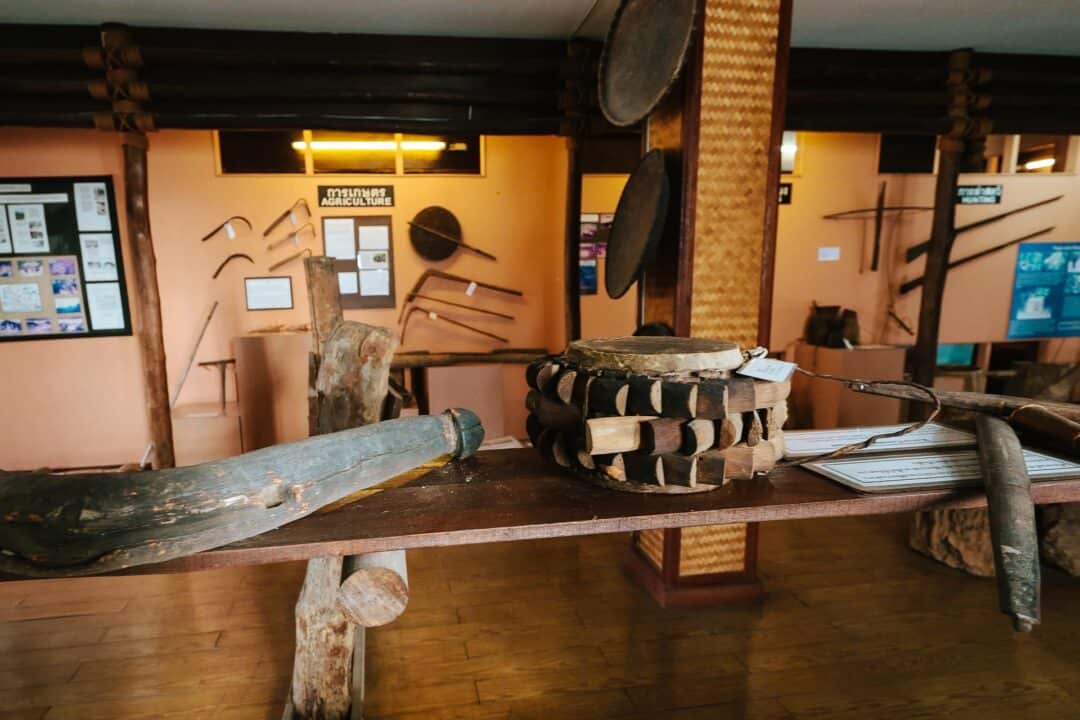
The Hilltribe Museum is a lesser-known attraction in Chiang Rai, but an absolute must-visit for anyone interested in anthropology and the heritage of the ethnic minorities in Thailand.
The Hilltribe Museum is named for the “hill tribes” of Thailand – including the Akha, Hmong, Karen, Lahu, Lisu, and Yao, among many others.

The museum features exhibits that provide insights into the daily lives, customs, and cultural practices of the hill tribes. These include traditional costumes, tools, musical instruments, jewelry, and household objects.
While the museum is a bit rough around the edges, it has TONS of information about each tribe, so it’s enriching from an educational standpoint.
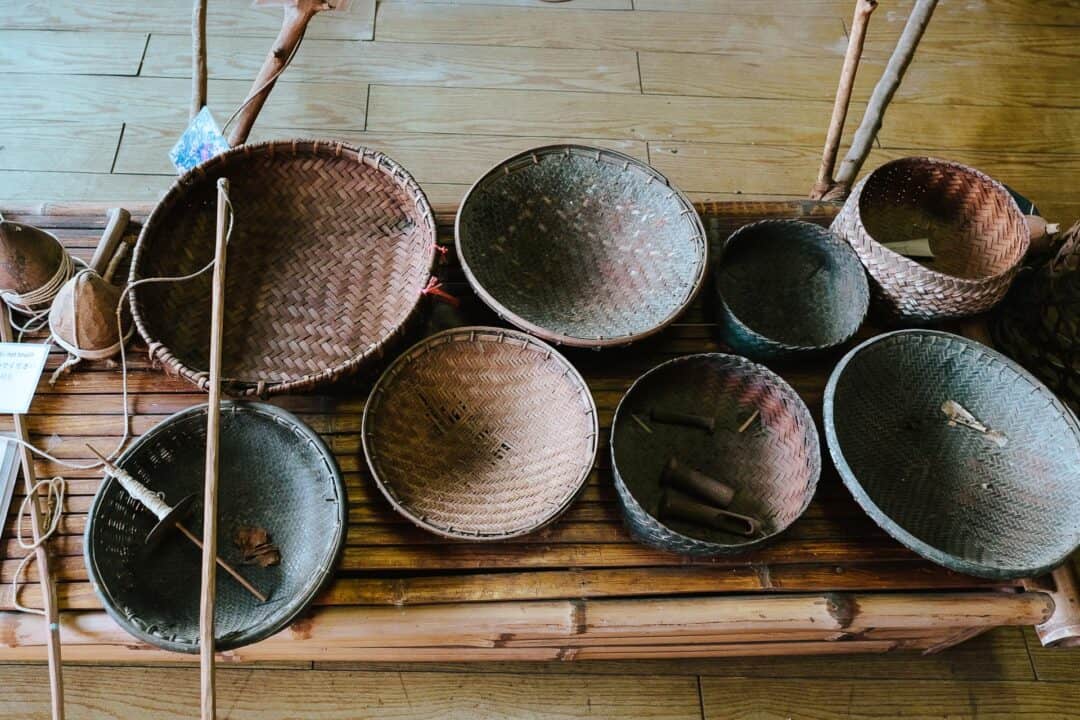
Each exhibit is carefully curated to offer visitors a comprehensive understanding of the hill tribes’ ways of life, from agriculture and handicrafts to spiritual beliefs and ceremonies.
Chiang Rai Night Bazaar
- Hours: 6:00 PM – 11:00 PM daily (hours vary depending on the stall)
- Location: 📍 Chiang Rai Night Bazaar – Google Maps
Every night, Chiang Rai’s Night Bazaar turns into this lively spot where you can eat, shop, and chill out.

You’ve got stalls upon stalls selling everything you didn’t know you needed. T-shirts that shout “I’ve been to Thailand,” intricate wood carvings, bracelets, bags, and more. It’s like the classic Thai night market scene but with its own Chiang Rai twist.

The night bazaar’s main attraction is its food court surrounded by stalls. You can order food from any of the stalls and sit down in the seating area in the middle to enjoy your meal.
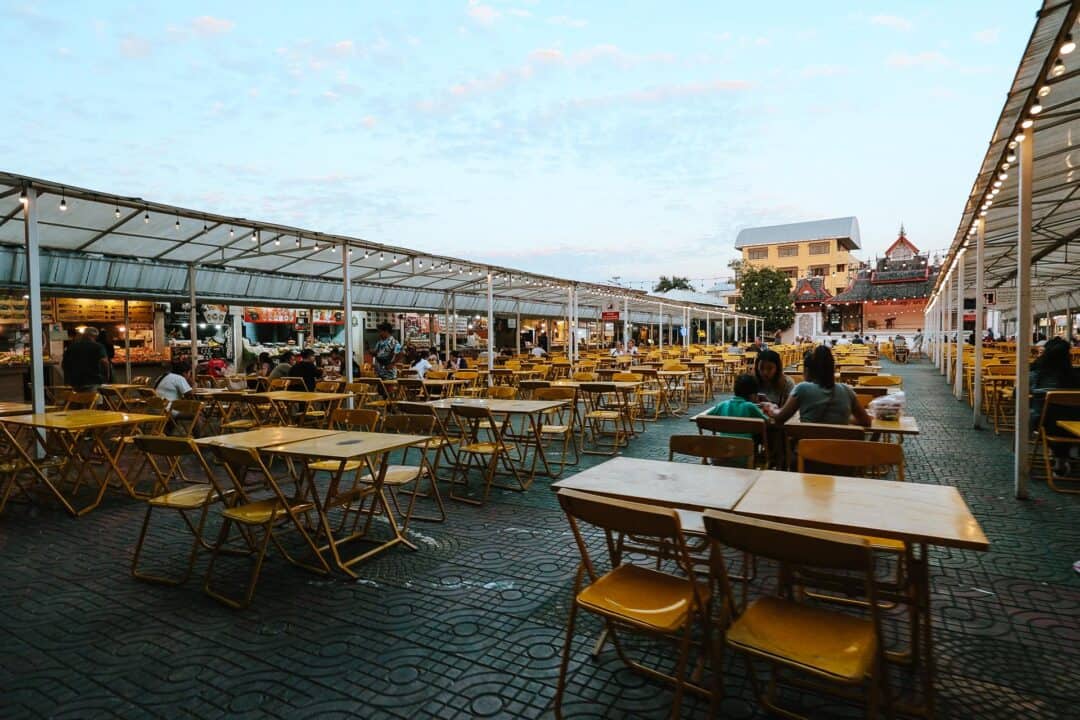
The food court even has a stage where local musicians do their thing while you enjoy your dinner. It adds a nice touch for a laid-back evening after a day of exploring.
The night bazaar is known for its hot pot. They serve it in a clay pot, heated over charcoal instead of gas, which is pretty cool. We tried it… it was alright. Not mind-blowing, but for the price? No complaints. It’s one of those “you get what you pay for” moments, but still worth the experience for the novelty factor alone.

Chiang Rai Clock Tower
- Hours: 24 Hours a day. Daily light and sound show at 7:00 PM, 8:00 PM, and 9:00 PM
- Location: 📍 Chiang Rai Clock Tower – Google Maps
The Clock Tower is a central landmark in Chiang Rai. The tower was designed by Chalermchai Kositpipat, the same architect as the White Temple, and features detailed carvings and decorations that are characteristic of his style.

The Clock Tower was built in 2008 to commemorate His Majesty King Bhumibol Adulyadej’s 80th birthday. Since its completion, it has become one of Chiang Rai’s most photographed landmarks, representing the fusion of tradition and modernity in art.
Located in the middle of the city in the middle of a roundabout, it’s likely that you’ll walk or drive by the clock tower a few times when you visit Chiang Rai.
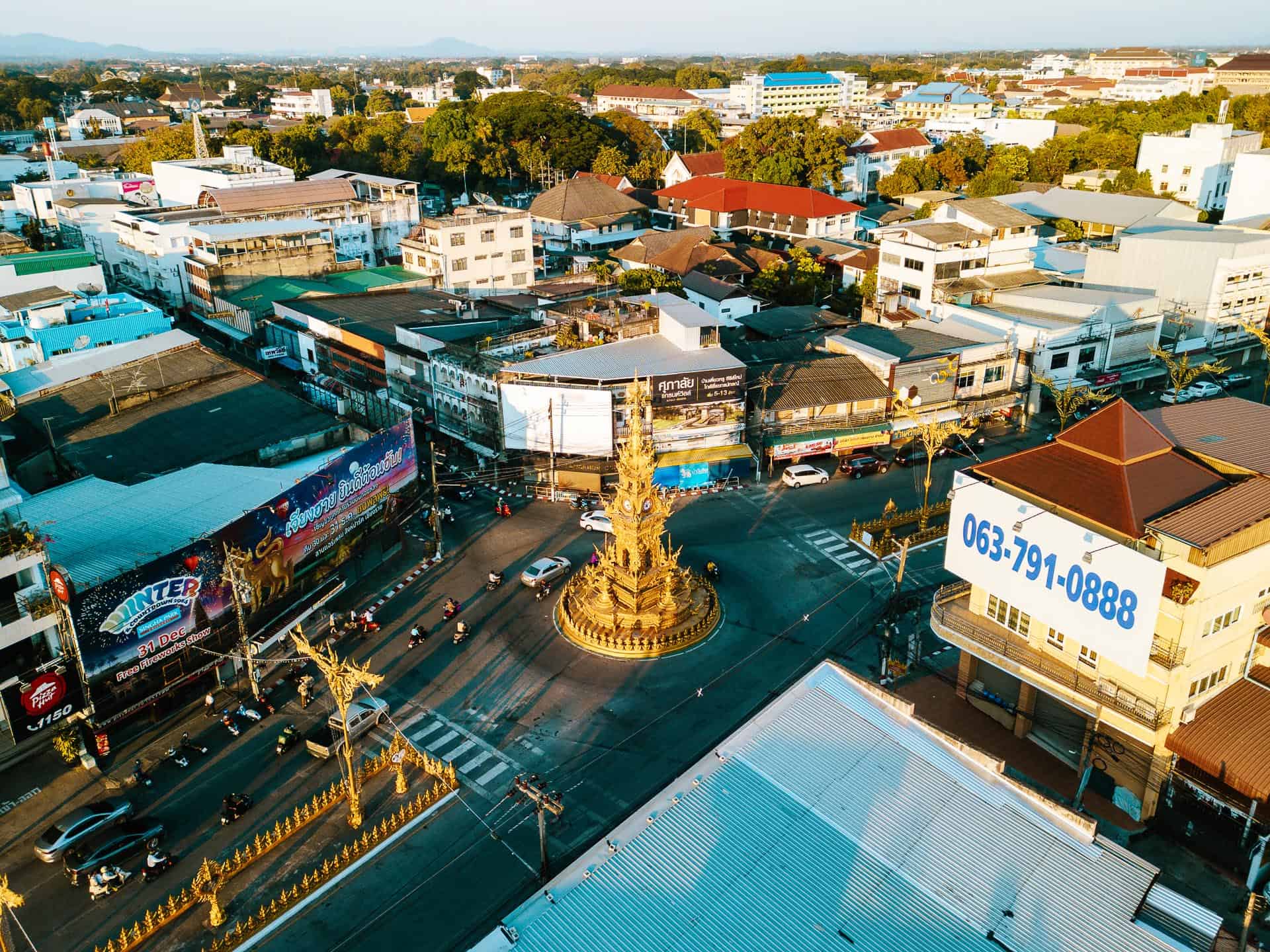
During the day, the clock tower’s golden hue glows from the sunlight. But nighttime is when the clock tower comes alive. Every night at 7:00 PM, 8:00 PM, and 9:00 PM, the clock tower performs a light and music show. The lights illuminate the tower, highlighting its intricate designs and casting a magical glow over the surrounding area.
Chiang Rai Flower Festival
- Dates: Mid-December ~ mid-January
- Cost: Free
- Location: 📍 75th Anniversary Flag and Lamp Park – Google Maps
- Official Website: Chiang Rai Flower Festival Facebook Page
The Chiang Rai Flower Festival is a colorful event that takes place annually in the cool season, usually in December and January.
This festival transforms the 75th Anniversary Flag and Lamp Park into a mesmerizing display of flowers, attracting both locals and tourists to Chiang Rai.

The festival showcases an array of vibrant floral displays in themed gardens with thousands of flowers, including regional specialties.

We went to the festival and strolled through areas such as the hydrangea and tulip lane and it was the perfect place to take cute photos and videos.

The best part is that it was 100% free to attend festival grounds and take photos. It was an awesome way to enjoy an evening in Chiang Rai.

Where to Stay in Chiang Rai
There are many choices of accommodation in Chiang Rai, from budget hostels to luxury villas in the countryside.
Top Places to Stay in Chiang Rai

- Budget Hostel in Chiang Rai: BED Friends Poshtel is where we stayed.
How to Get to Chiang Rai
Getting to Chiang Rai is relatively straightforward, as multiple methods of transportation suit different budgets, time constraints, and travel styles.
Here are some of the most common ways to get to Chiang Rai:
Chiang Rai Day Trip from Chiang Mai
If you are based in Chiang Mai you can check out the top-rated Chiang Rai White Black Blue Temple Full Day Tour, which includes transportation and a guide.
By Bus
Long-distance buses are the most straightforward and budget-friendly option. When we visited Chiang Rai we booked a bus with 12Go. The bus journey from Chiang Mai to Chiang Rai took us approximately 3.5 hours.
By Car
Renting a car gives you the freedom to explore Chiang Rai at your own pace. The best part about renting a car to go to Chiang Rai is that you won’t need to rely on tuk-tuks or Grab to get around the city. The drive from Chiang Mai to Chiang Rai takes about 3.5 hours, depending on traffic and weather conditions.
By Air
The fastest and most direct route to Chiang Rai is by air. Mae Fah Luang-Chiang Rai International Airport welcomes flights from major cities across Thailand, including Bangkok, with daily services provided by several airlines. The airport is just a short drive from the city center, so it’s the quickest way to get to Chiang Rai from anywhere in Thailand.
How to Get Around Chiang Rai
There are a few ways to get around Chiang Rai. Some transportation methods are ideal for exploring attractions close to the city and others are more suited for reaching destinations further away.
Walking
Walking is a great choice if you’re staying within the city limits of Chiang Rai.
Many of Chiang Rai’s key sights, including the Hilltribe Museum, Night Bazaar, Clock Tower, and the Flower Festival, are accessible by foot if you’re staying in the city.
Songthaews and Tuk-Tuks
For journeys slightly beyond walking distance, tuk-tuks and songthaews are the best local modes of transport. These can be hired for round trips to nearby destinations, such as Blue Temple and Black House. The initial price from the driver can often be negotiated down, so don’t hesitate to barter for a better deal.
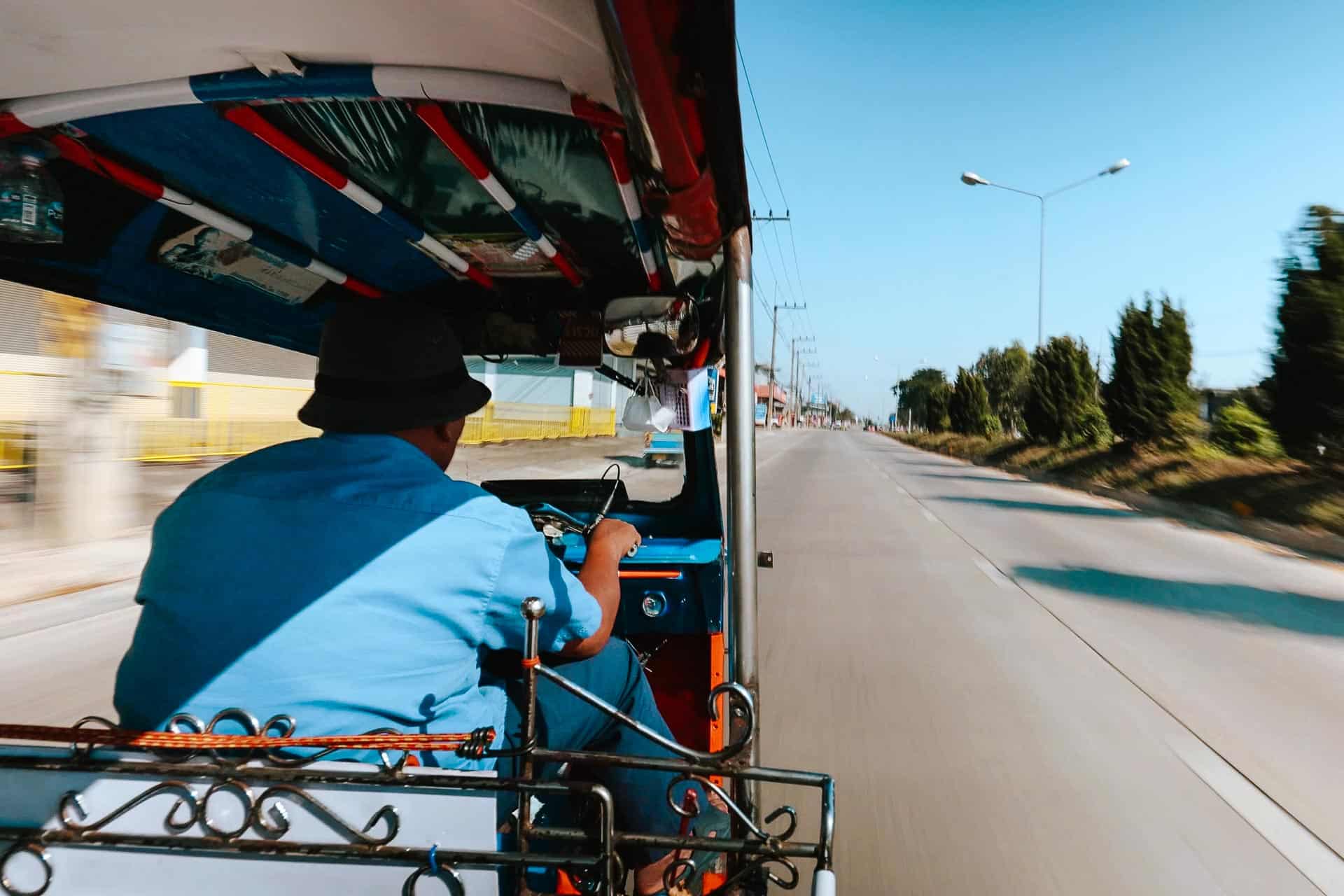
Rideshare (Grab)
Grab provides a modern and efficient solution for short, one-way trips around Chiang Rai. It’s particularly handy for visits to places like the White Temple. However, for attractions far from the city, like the Khun Korn Waterfall, Grab might not be the best option due to its distance from the city.
Motorbike Rental
Renting a motorbike offers freedom and flexibility if you can ride a motorbike. Motorbike rental daily rates range from 150 to 300 baht depending on the model. It’s an ideal choice for reaching destinations outside the city at your own pace. We rented a motorbike to visit the Khun Korn Waterfall since it is over 30 km away from Chiang Rai.
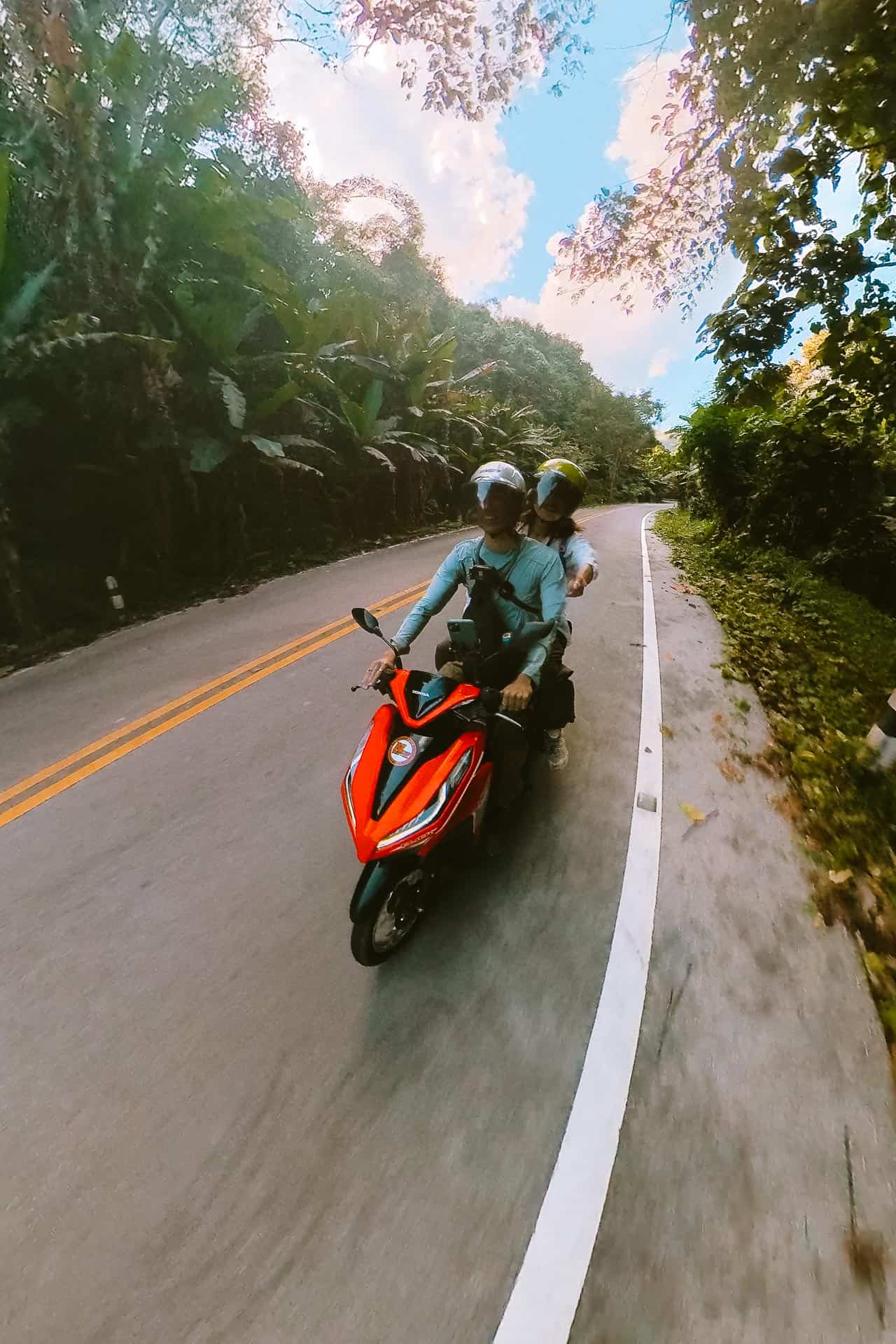
Day Tour
Alternatively, if you prefer a more structured itinerary or are not inclined to navigate on your own, booking a tour through platforms like Klook can be an excellent option
If you prefer a more structured itinerary, you can book a tour to Chiang Rai from Chiang Mai on Klook. The tour picks you up at your accommodation in Chiang Mai, then goes to the Blue Temple, White Temple, and Black House, and then drops you off back in Chiang Mai.


